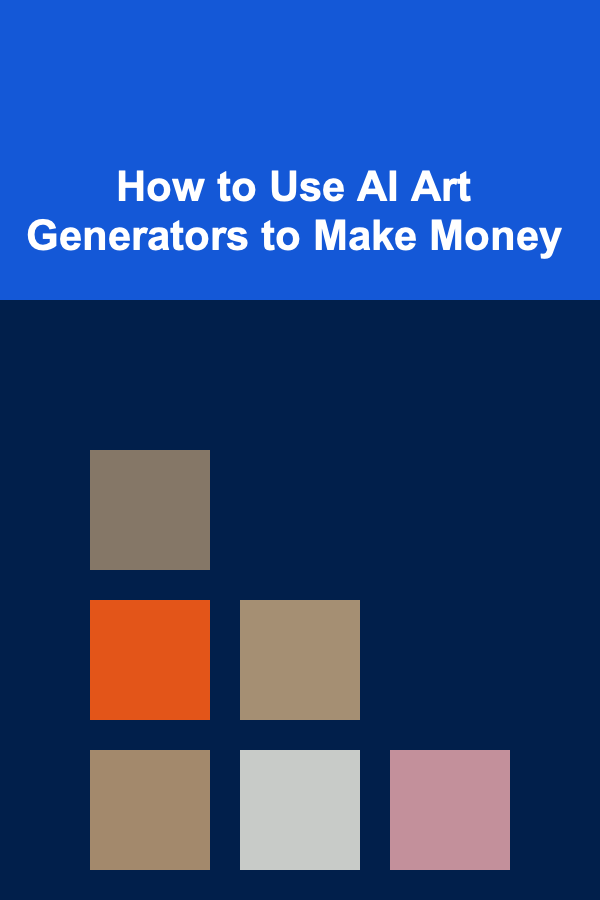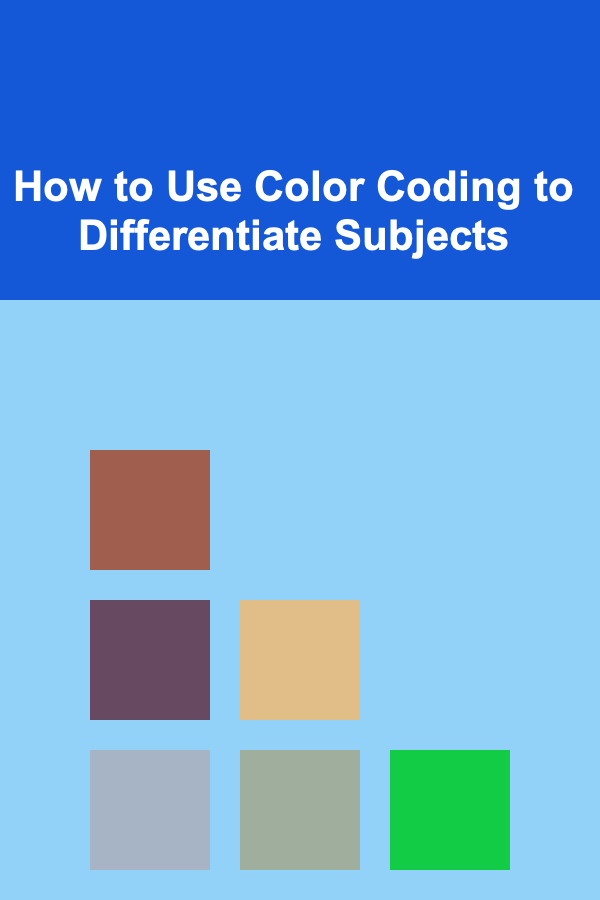
How to Use AI Art Generators to Make Money
ebook include PDF & Audio bundle (Micro Guide)
$12.99$9.99
Limited Time Offer! Order within the next:

In recent years, the rise of Artificial Intelligence (AI) has been a game-changer in many industries, and the world of art is no exception. AI Art Generators, powered by deep learning algorithms, have enabled people to create unique, stunning artwork with minimal effort. These tools are accessible to a wide range of users, from artists looking to enhance their craft to entrepreneurs seeking new opportunities to monetize their creative skills.
This article explores how you can leverage AI Art Generators to make money, whether you are a digital artist, entrepreneur, or someone just starting out. We'll dive into different methods, platforms, and strategies to help you turn your AI-generated artwork into a profitable venture.
What Are AI Art Generators?
AI Art Generators are tools that utilize artificial intelligence to generate or enhance digital artwork. These tools typically rely on neural networks, deep learning, and generative adversarial networks (GANs) to produce images based on user input. Some AI Art Generators allow users to create artwork from scratch, while others enhance or modify existing images based on stylistic preferences.
Some well-known examples of AI Art Generators include:
- DALL·E 2 by OpenAI
- Artbreeder
- DeepArt
- RunwayML
- NightCafe
- StarryAI
These platforms offer users a wide range of possibilities, from transforming photos into artworks resembling famous painting styles to generating entirely new pieces based on a text prompt. The user-friendly interfaces make it possible for people without any artistic skills to create professional-quality art, opening up new avenues for monetization.
Why AI Art Generators Are Profitable
Before diving into the specifics of how to make money with AI-generated art, it's important to understand why AI Art Generators can be a profitable venture.
- Low Initial Investment: Traditional art creation often requires expensive materials, tools, and years of practice. In contrast, AI Art Generators can be accessed with a simple subscription or one-time payment, significantly reducing startup costs. You don't need a studio or an expensive art set---just a computer or a smartphone with access to the AI tools.
- Scalability: Once you master how to use an AI Art Generator, you can produce a high volume of artwork in a relatively short amount of time. This scalability gives you the ability to generate a wide range of art, which can be used for different monetization methods, from prints to NFTs.
- Unique and Customizable Art: AI-generated art can be highly customizable, allowing you to create one-of-a-kind pieces. This uniqueness is a valuable commodity in today's art market, where buyers are increasingly looking for original and innovative works.
- Growing Demand for Digital Art: As digital art becomes more mainstream, both individuals and businesses are increasingly interested in purchasing digital artwork for various purposes, including personal collections, marketing campaigns, website designs, and social media content.
- Accessibility: AI Art Generators are accessible to anyone with an internet connection, allowing people from all over the world to create art. This global reach expands your potential customer base, making it easier to find buyers for your work.
Now that we've covered the reasons why AI Art Generators are a profitable opportunity, let's explore the various ways you can monetize AI-generated art.
Ways to Monetize AI-Generated Art
1. Sell Digital Art Prints
One of the most straightforward ways to make money from AI-generated art is to sell digital prints. You can upload your artwork to online platforms and sell it as downloadable files, which customers can then print on their own. This model allows you to sell the same piece of art multiple times without any additional production costs.
Platforms to sell digital prints:
- Etsy: A popular marketplace for handmade, vintage, and digital products. Etsy has a large community of buyers looking for unique digital artwork.
- Redbubble: A print-on-demand platform where artists can upload their designs, and Redbubble handles the printing, shipping, and customer service.
- Society6: Similar to Redbubble, Society6 offers a platform for artists to sell digital art that can be printed on a variety of products, including posters, tapestries, and home decor.
- Creative Market: This platform allows artists to sell digital art as stock images, graphics, and other digital products.
To maximize your earnings, you can also offer your artwork in various formats, such as high-resolution files, vector art, and different print sizes. This gives customers the flexibility to choose the product that best fits their needs.
2. Create and Sell NFTs
The rise of NFTs (Non-Fungible Tokens) has opened up a new avenue for digital artists to monetize their work. NFTs are digital assets stored on the blockchain that represent ownership of a unique piece of digital art. Artists can mint (create) NFTs of their AI-generated artwork and sell them on NFT marketplaces.
Platforms to sell NFTs:
- OpenSea: The largest and most popular NFT marketplace. You can create and sell NFTs of your AI-generated art directly on OpenSea.
- Rarible: Another well-known NFT marketplace where creators can mint and sell their art.
- Foundation: A platform that focuses on high-quality digital art and is selective about the artists it allows to mint NFTs.
- SuperRare: A marketplace for digital art where artists can sell their unique, tokenized pieces of art.
The key to success in the NFT market is to build a brand and establish a reputation. This involves promoting your art on social media, connecting with other NFT artists and collectors, and providing unique and valuable pieces. You can also experiment with different approaches, such as limited-edition releases or special perks for buyers (e.g., exclusive content or access to future drops).
3. Offer Custom Artwork Services
AI Art Generators allow you to create customized artwork based on a client's specific requests. This opens up opportunities to offer personalized art services, where you can take commissions from individuals, businesses, or organizations.
For example, you can offer:
- Custom Portraits: Create AI-generated portraits based on photographs provided by clients.
- Logo Design: Use AI Art Generators to design unique logos for businesses or individuals.
- Marketing Material: Produce digital artwork for use in advertising, social media, or other promotional materials.
Platforms like Fiverr and Upwork can be excellent places to market your custom artwork services. By building a strong portfolio and receiving positive reviews, you can attract more clients and increase your earning potential.
4. Sell Art on Merchandise
Another way to monetize AI-generated art is by turning your designs into merchandise. You can print your artwork on a variety of products, including T-shirts, mugs, phone cases, and posters, and sell these items through online stores or print-on-demand platforms.
Print-on-demand platforms:
- Printful: A print-on-demand service that integrates with e-commerce platforms like Shopify and Etsy, allowing you to sell custom merchandise without holding inventory.
- TeeSpring: A platform that allows you to create and sell custom products with your artwork, including apparel, accessories, and home decor.
- Zazzle: Similar to Redbubble and Society6, Zazzle allows artists to upload their designs and sell them on a variety of products.
With print-on-demand, you can sell your artwork on merchandise without worrying about production or shipping. The platform handles all the logistics, and you receive a percentage of the sales.
5. Build a Social Media Following and Monetize with Sponsorships
Building a social media presence around your AI-generated artwork can help you attract followers, create a loyal fanbase, and generate income through sponsorships and collaborations. Platforms like Instagram , TikTok , and YouTube are excellent for sharing digital art and engaging with your audience.
Once you have built a following, you can monetize your content by:
- Partnering with brands for sponsored posts.
- Offering paid tutorials or art classes.
- Promoting your merchandise or digital artwork.
- Running paid ads on your social media profiles.
Social media platforms are an excellent way to showcase your creative process, share behind-the-scenes content, and engage with potential buyers. By building a personal brand, you can also leverage collaborations with other artists or influencers to expand your reach and attract more opportunities.
6. Create Digital Art for Video Games or Apps
AI-generated art can also be used in video games, mobile apps, or other digital projects. Indie game developers and app creators often seek unique artwork to incorporate into their projects, and you can offer your AI-generated art as assets for these creators.
You can create:
- Game Textures: Use AI to generate textures for characters, backgrounds, or environments in video games.
- Game Characters: Design unique characters or avatars for video games or apps.
- Icons and UI Elements: Create custom icons, buttons, or other interface elements for mobile apps or websites.
Websites like Unity Asset Store and Itch.io allow creators to sell digital assets for video games. You can upload your art to these platforms and make money from game developers and app creators looking for fresh, unique artwork.
Tips for Success in AI Art Monetization
- Find Your Niche: The world of AI-generated art is vast, so it's important to find a niche that resonates with your target audience. Whether it's creating AI-generated abstract art, custom portraits, or digital illustrations for games, finding a specific style or theme will help you stand out and attract a loyal following.
- Promote Your Work: Building a strong online presence is essential for making money with AI art. Use social media, art communities, and online marketplaces to promote your work and connect with potential buyers.
- Engage with Your Audience: Whether you're selling prints, NFTs, or custom commissions, engaging with your audience is key to building trust and maintaining long-term success. Respond to comments, share your creative process, and offer incentives like discounts or exclusive content.
- Keep Experimenting: AI art is a rapidly evolving field, and there are always new techniques, platforms, and opportunities emerging. Stay updated on the latest developments in AI art and continue experimenting with different tools, styles, and formats to keep your work fresh and innovative.
Conclusion
AI Art Generators offer an exciting opportunity for artists, entrepreneurs, and creators to make money through digital art. Whether you're selling digital prints, NFTs, custom commissions, or merchandise, there are numerous ways to monetize your AI-generated artwork. The key to success lies in finding your niche, building a brand, and leveraging multiple platforms to reach your audience. With the right strategy and dedication, AI-generated art can become a profitable and rewarding venture.
Other Products

How to Cook Healthy for a Crowd
Read More
How to Create a Functional, Space-Saving Dining Area
Read More
How to Maintain Your Home's Lighting Fixtures for Safety and Style
Read More
How to Understand the History of Craft Beer
Read More
How to Use Color Coding to Differentiate Subjects
Read More